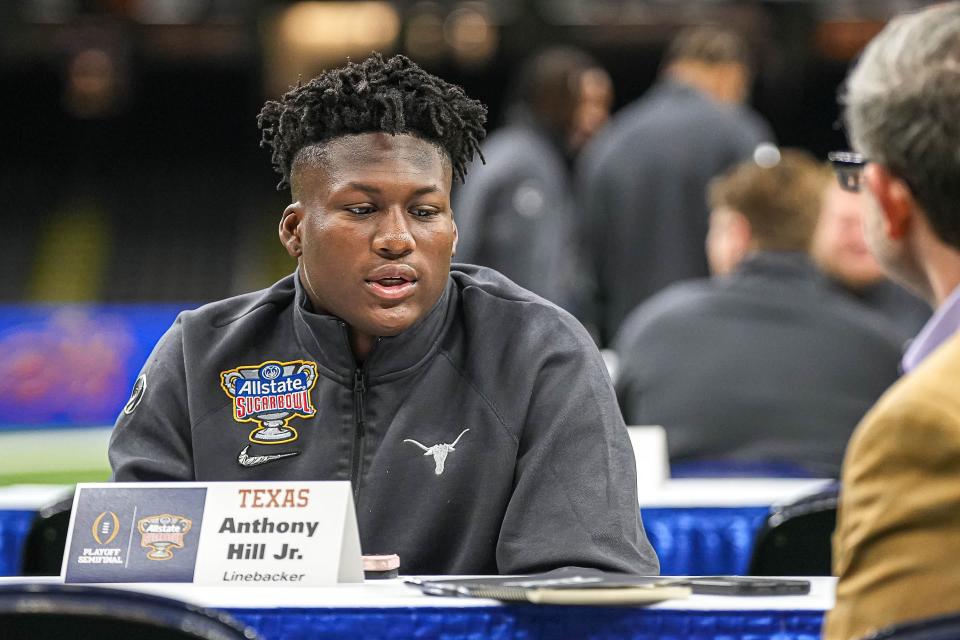Which Texas football defensive player has helmet radio? No clear signal by Steve Sarkisian
Texas football coach Steve Sarkisian and his staff have spent this spring tweaking their systems on both sides of the ball, incorporating some new faces in key places and getting third-year starting quarterback Quinn Ewers comfortable with the NCAA’s upcoming rule allowing a helmet communication system with the coaches.
But what about those communications on the defensive side of the ball? That will just have to wait, Sarkisian said.
“It's probably been a little bit more challenging than it would be from an offensive perspective,” Sarkisian said. “Not because we're not physically equipped to do it from a coach-to-player standpoint, (but) we just only have so many devices. So when you only have so many, you can only put so many in so many helmets per practice. So we've probably spent more time from an offensive perspective. But we will start to gravitate to the defensive side of the ball and spend a little bit more time on that.”
More: Texas football looks for plugs on the defensive line to replace Sweat, Murphy | Golden
Will helmet communication be allowed in 2024?
Sarkisian didn’t get into specifics about why Texas doesn’t have enough equipment to implement the technology on both sides of the ball. However, it’s been a fast-moving process for the NCAA in the wake of last year’s sign-stealing scandal at Michigan, and schools are trying to keep pace.
Earlier this spring, the NCAA rules committee proposed revamped technology rules for the 2024 season that include coach-to-player communications through the helmet of one player on the field. The proposal must be approved by the NCAA's playing rules oversight panel, which is scheduled to discuss football proposals Thursday.
That panel traditionally rubber-stamps proposals from the NCAA rules committee, which means college football is all but assured to mirror the NFL in 2024 on the use of a helmet communication system for one player on each side of the ball.
More: Texas focusing on culture this spring: 'Culture and talent, that's really dangerous'
Sarkisian, who has coaching experience in the NFL and serves as the Longhorns’ primary play-caller, has long been a proponent of an NFL-style communication system. During the height of the uproar over Michigan’s sign-stealing last November, Sarkisian groused, “I spend half of my week changing signals and signs rather than coaching the game of football.”
That’s begun to change this spring, even though Texas retains the signal-from-the-sideline system, just in case.
“I love it,” Ewers said. “I think it makes things a little bit easier for me. Obviously, we’re still signaling, but I still have Sark telling me the plays in the helmet. First day it was a little shaky just because I was getting used to it, but I think it’s going to be really helpful for me.”

More: Texas football offensive lineman Neto Umeozulu powering his way toward more playing time
Anthony Hill Jr. is the leading candidate for a helmet radio
So who'll have the radio in his helmet when Texas tunes to the frequency for the defense? Sarkisian said he hasn’t made that decision yet, but sophomore linebacker Anthony Hill Jr. looks like the leading candidate.
The Big 12’s defensive freshman of the year in 2023, the 6-foot-3, 243-pound Hill has settled in at middle linebacker after spending much of last season at outside linebacker or on the edge. As is almost inherent to the position, Hill has handled the signals and calls for the defense this spring.
“I feel like it's a blessing that they just allow me to be able to do this,” Hill said. “Just being able to communicate every day and do something I need to get better at and just working on it every day, it's important to me.”
David Gbenda, a sixth-year linebacker and one of the team’s locker room leaders, said he “assumes it’s going to be” Hill with the radio on defense. Regardless of who receives the calls from defensive coordinator Pete Kwiatkowski, Gbenda said the new technology will prove just as beneficial to the defense as it does to any offense.
“I feel like it will make it faster,” Gbenda said. “Instead of me having to look to the side, I’m looking at the offense. I don’t have to take my eyes off the offense. I’m seeing what they’re giving me. I understand the body language of the linemen and the body language of the receivers so I can pick up on the plays. I feel like it will just make the game faster and easier to pick up.
“In the NFL, that’s how they play anyway. It’ll just be preparation for the next level, in my opinion.”
This article originally appeared on Austin American-Statesman: Longhorns football team still waiting on helmet radio for defense

